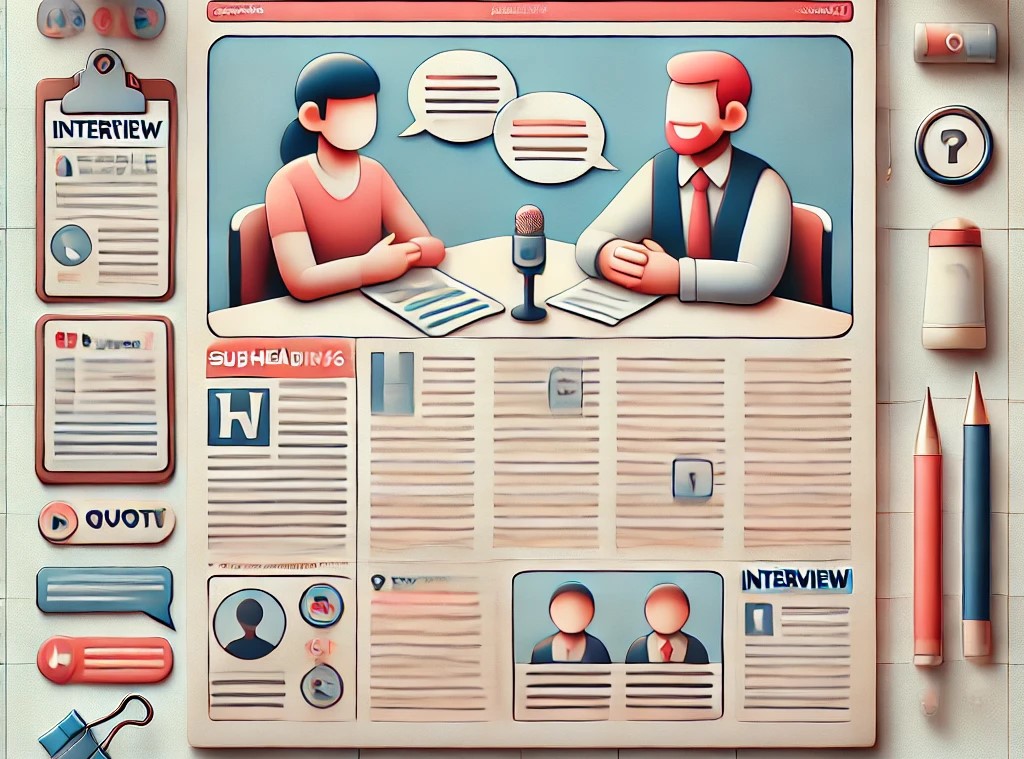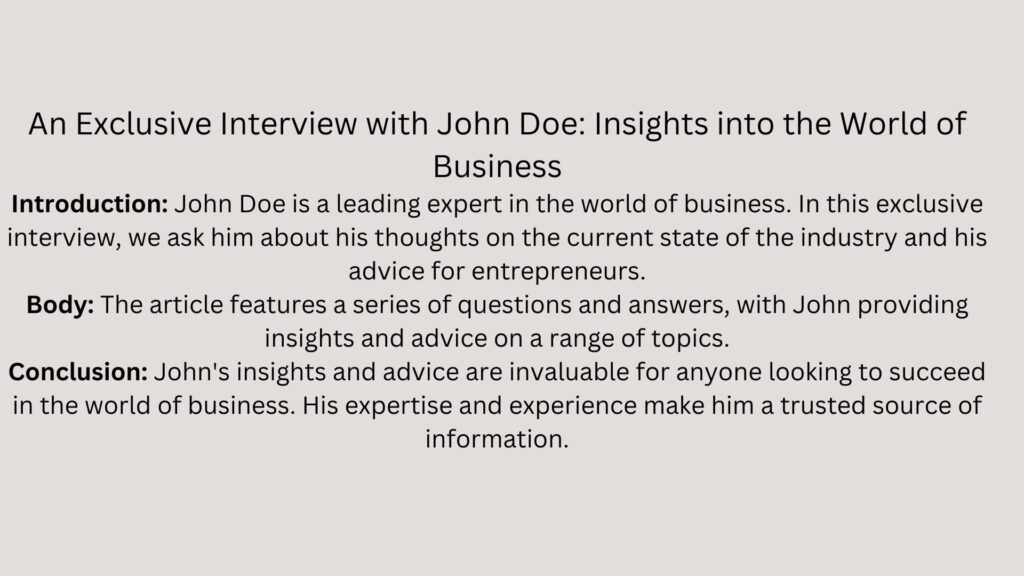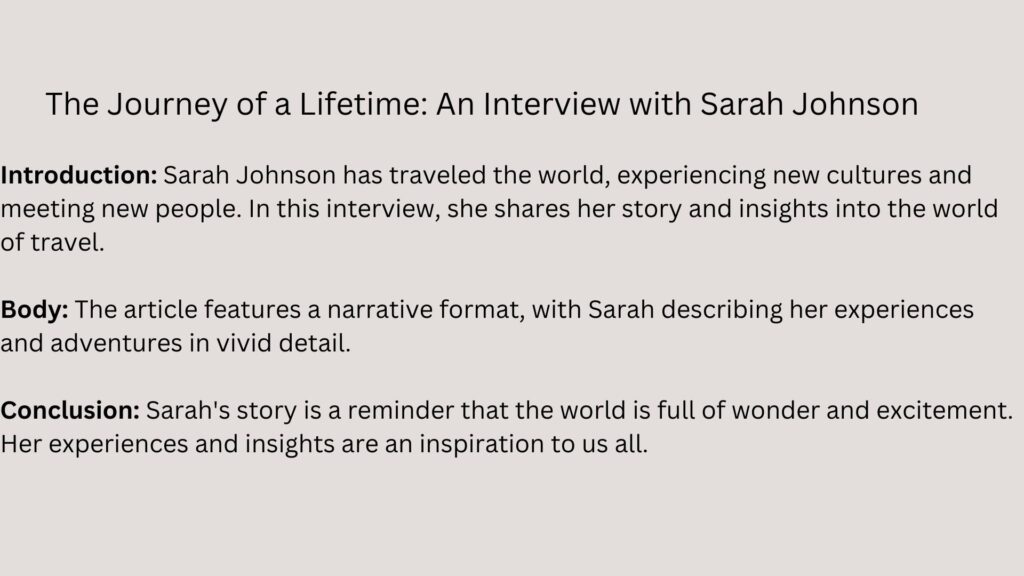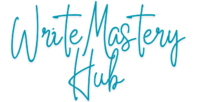……………………………….how to write an interview article examples………………………………..
Hey there, fellow writers! Do you find the continuous need to engage your audience, tell them interesting and compelling stories that will impress them?
Well, you’re in luck because today we’re going to talk about one of the most effective ways to do just that, writing an interview article.
It is one thing that will make you wish you could just order your favorite thought leader, entrepreneur or artist and have him or her explain real life as it is.
and the questions arises What would you ask them? In what manner would you present their story to the world?
Well, that’s exactly what we are going to do in this article – give you a good understanding of these two.
Why Interview Articles Matter

In today’s digital age, we’re constantly bombarded with information from every direction. But amidst all the noise, there’s something special about reading an interview article that makes us feel like we’re getting a glimpse into someone’s inner world.
Basically, it’s as if you are talking to the person but you don’t get to know them on a personal level.
Interview articles must have the power to:
- Encourage us to do something in relation to the ideas presented.
- Share useful recommendations and vivid examples from other’s experiences
- It must give another vantage point to a specific subject or sector.
- Befriend the faces behind our favorite brands and companies
But come on. It’s not all fun and games; conducting an Interview Article can be quite daunting if one is new to it.
Where do you start? How do you prepare? What questions do you ask? Have no fear though because here at this site, we are going to offer you a piece of our mind.
So in this article, let’s hold your hand and guide you step by step to writing a successful interview article that will entertain, motivate and educate your reader.
We’ll go through some best practices, some useful hints to follow and examples to use, to guide you.
By the end of this article, you should be able to go out and write an interview article that will have your readers in a trance.
Pre-Interview Preparation: The Key to a Successful Interview Article
In this article we found out that Interview articles are important so now let’s look at some practical aspects of how to prepare for an interview.
This is arguably the most important area, this is where the real action is people! A good interview set up is the core of any interview article.
Step 1: Researching the Interviewee and Their Work
When it comes to coming up with interview questions, there is absolutely no way that you can get it right unless you research the person you are interviewing.
This means studying all that they do and have done including information about the company or organization they are associated with.
Here are some ways to get started:
- While it is easy to misjudge someone’s personality, reading their Books, articles, or blog posts will help you better understand the overall tone and language they use.
- You can look up their profiles on social media to find out what brings them to work and what they are busy with.
- Look up their interviews as they given in the past because it can be interesting to see how they answer different questions.
- Visit their website or portfolio in order to see the scope of their practice and what they are engaged with.
By doing your research, you’ll be able to:
- Find out what questions to ask the interviewee during the interview
- Create sound and meaningful questions
- Make sure your interviewee knows how interested you are in their everyday job
Step 2: Preparing Thoughtful and Open-Ended Questions
As you prepare for an interview, you need to come up with questions that will enable you get the best information.
Here are some tips to keep in mind:
- Minimize yes or no questions – they’re not going to give you much to work with in terms of quotes or insights
- Opt for open-ended questions that encourage the interviewee to share their thoughts and experiences
- Make the questions that you ask with reference to the research questions, better and more specific.
- Consider using the STAR method to structure your questions: Situation, Task, Action, Result
Here are some examples of thoughtful and open-ended questions you might ask:
- Could you explain an unforgettable project you had overcame any problem and how you succeeded in the task?
- How did you begin your career path, and if you were starting over again what would you do?
- What’s the most important lesson you’ve learned throughout your career, and how has it impacted your work?
Step 3: Setting Clear Goals and Objectives for the Interview
Before you conduct the interview, it’s essential to define what you hope to achieve. What’s the purpose of the interview? What do you want to learn from the interviewee?
Here are some questions to consider:
- what is one primary focus or idea you would like to discuss during the interview?
- What kind of tone do you want to convey in the interview article – formal, informal, inspirational, etc.?
- Are there any special question or statement, which you expect the interviewee to respond to?
By setting clear goals and objectives, you’ll be able to:
- Do not get distracted during the interview and make sure that you are getting what you want
- Establish order in your interview article
- Make sure that your interview article fits the purpose and requirements of your reader
Conducting the Interview: The Art of Conversation

Here you are ready with your questions and research work, it’s time to go for the Interview.
This is the sort of place where the real action takes place folks! A great interview is all about creating a comfortable and relaxed atmosphere, actively listening to your interviewee, and asking follow-up questions to probe for more information.
Creating a Comfortable and Relaxed Atmosphere
Take several minutes of your time before you begin to fire your questions and make the patient feel as comfortable as possible.
Here are some tips to help you do just that:
- Initiate with a simple conversation to make the interviewee comfortable
- State that you are going to conduct an interview and what you expect to gain from it
- Ensure you are alone and in a place where there will be no interruptions or interference.
- Let your interviewee feel comfortable; you might offer them a glass of water or cup of coffee.
By creating a comfortable atmosphere, you’ll be able to:
- Comfort your interviewee and let him/her relax
- Encourage them to talk about what they know and have experienced
- Gain the interviewee’s confidence and get on their good side
Outcomes of Active Listening and Note Taking Skills
Since you have succeeded in making your interviewee feel at ease, you should proceed to listen to him/her. This also means listening to the things they are uttering and gestures they are making.
Here are some tips to help you do just that:
- Do not look around, and ensure that you keep an eye contact with the person you are talking to.
- take a note what the interviewee has to say to you, but do not interrupt them frequently.
- It is recommended to say ‘uh-huh’ and ‘I see’ and the likes while interacting with the speaker.
- Ask clarifying questions to make sure you understand what they’re saying
By actively listening and taking notes, you’ll be able to:
Paraphrase the idea behind everything the particular subject is uttering
Determine main ideas and findings that you can apply in your article
Show your interviewee that you’re genuinely interested in what they have to say
Asking Follow-Up Questions and Probing for More Information
Now that you’ve asked your initial questions, it’s time to start asking follow-up questions and probing for more information.
This is where the real magic happens, folks!
By asking follow-up questions, you’ll be able to:
- You should gather more specific and detailed information from your interviewee
- Clear your misunderstandings in regard to the stipulated problems.
- This could be a positive prompt to your interviewee to give you more thoughts into the discussion or experiences to share out on.
Here are some examples of follow-up questions you might ask:
- Can you give me an example of that?
- What was your feeling about that experience?
- What lesson can you draw from that experience?
By asking follow-up questions and probing for more information, you’ll be able to:
- Get the most out of your interview and create a compelling article
- Let your interviewees know that you care about their stories and experiences
- Create a more engaging and informative article for your readers
Writing the Interview Article: Bringing the Story to Life

The interview is over and you have your note pad full of points that you made, it is now about time to write your article.
This is where the magic happens, folks! In an interview, A great interview article is all about structuring the story, using quotes and anecdotes to bring it to life, and editing and revising for clarity and flow.
Structuring the Article and Creating a Compelling Narrative
Now with regards to the Structuring of the article, there may be a few important things to remember.
Here are some tips to help you create a compelling narrative:
- start with a hook to grab the reader’s attention
- Use a clear and concise introduction to set the scene
- Break the article into sections or subheadings to make it easier to read
- Use transitional phrases to connect the different sections and create a flow
Here’s an example of how you might structure an interview article:
- Introduction: Briefly tell about the interviewee and about the position he holds
- Section 1: Discuss the interviewee’s background and experience
- Section 2: Discuss the interviewee’s mindset regarding some issue
- Conclusion: Summarize the major points and offer some additional comments
By structuring the article in a clear and concise way, you’ll be able to:
- Establish personas that will engage the reader to the story
- Use simple language and words to write the article
- Emphasize the key points and lessons learned
Using Quotes and Anecdotes to Bring the Story to Life
Interview articles are the best sources of information, but one can always spice it up with quotes and anecdotes.
Here are some tips to help you do just that:
- Quotes help to make the article informative and give an understanding of the particular problem deeper
- Anecdote is a good way to explain when something happened to get acquainted with a foreign audience or make the story more personal
- They should write the story with lot of descriptions in order to make the whole story more creative
- Use dialogue to create a sense of conversation and make the article more engaging
Here’s an example of how you might use quotes and anecdotes in an interview article:
“I remember when I first started out in the industry,” said John. “I was so nervous and unsure of myself. But I learned quickly and was able to adapt to the challenges.” “One of the biggest lessons I’ve learned is the importance of perseverance,” said Jane. “There have been times when I felt like giving up, but I kept pushing forward and eventually achieved my goals.”
By using quotes and anecdotes, you’ll be able to:
- Expand content knowledge and create suggestions for the material.
- The article should make the story more personal and interesting.
- Create a sense of conversation and make the article more enjoyable to read
Editing and Revising the Article for Clarity and Flow
After you have completed writing the article now its time to edit and revise it.
Here are some tips to help you do just that:
- Read the article out loud to check for clarity and flow
- check grammatical and spelling mistakes as well
- See that the whole article does not appear very academic or bulky
- Ask other people’s opinion and modify the identified patterns as necessary.
By editing and revising the article, you’ll be able to:
- Generate a simple and straightforward article that is not complicated
- Remember to check for error and ensure they article is well structured and well flowing
- Ensure that the article is engaging and enjoyable to read
Examples of Interview Articles: A Closer Look

Now that we’ve covered the basics of writing an interview article, let’s take a closer look at some examples of different types of interview articles.
We’ll analyze what makes each example effective and provide some tips on how to incorporate these techniques into your own writing.
Example 1: Profile Piece
An interview piece is a magazine article that interviews an individual and gives information about their life.
Here’s an example of a profile piece:

What, however, makes this example rather effective?
- The writer utilizes the title and the introduction part to capture the attention of the reader.
- The use of quotations from Jane to enrich the article.
- Descriptive language is used in the story as a way to make the story more alive.
Example 2: Q&A
A Q&A or question and answer is an interview based article that is presented in questions and answers.
Here’s an example of a Q&A:

What makes it effective?
- The way the information was organized in a concise manner to ensure that all relevant data was clearly seen
- This paper incorporated responses to questions with thought-provoking and informative answers from John
- The way of framing the article in an informal manner in order to establish a friendly conversation for the readers
Example 3: Narrative Interview
A narrative interview is an interview article that focuses on using a description of events and plenty of descriptive attributes to describe events.
Here’s an example of a narrative interview:

Why can this example be considered as efficient?
- the use of descriptive language to enhance the narration of the story
- The inclusion of vivid imagery to create a sense of atmosphere and mood
- The portrayal of meaning through the storytelling approach
Tips and Best Practices: How to Write an Interview Article that Engages and Inspires
Now that we have covered the basics of writing an interview article, let’s take it to the next level with tips and best practices.
Common Mistakes to avoid
Okay, let us begin with some common mistakes, which you should avoid with an interview article. There are a few things you can watch out for.
Do not ask too many questions
Curiosity is great, but too many questions might give an article an interrogative feel. Ask only the most important questions and let the conversation flow spontaneously.
Do not interrupt the interviewee
Let the interviewee complete their thoughts before you have another question ready. Interrupting may make the article choppy and disjointed.
Remember to verify facts
Verify that the information given by the interviewee is correct and not a fallacy.
Tips for a Compelling and Shareable Article
Having talked about what shouldn’t be done, it would be worthwhile to know which factors should make an article shareable.
A few pieces of advice follow:
Write it using the informal tone of conversation
Be approachable and engaging, avoiding jargon or overly technical language that might confuse readers.
Use rich and descriptive words to describe an article
bring alive a picture of that interviewee and all their experiences.
Use quotes and anecdotes
This would add more depth and insight to the article if done through quotes and anecdotes with the interviewee. This can help the reader connect personally with the interviewee.
Here are some additional tips to help make the post shareable:
Use social media-friendly headlines
This includes using short headlines that are catchy and optimized for social media.
Use eye-catching images
Use images that are of high quality, relevant, and catch the eye.
Write in simple concise form
A clear and concise format helps make the article highly readable and intelligible.
Step-by-Step Guide to Writing an Interview Article
Here’s how to write a professional interview article:
no1# Prepare for the interview
Research the interviewee and their work to get a sense of their background and expertise.
no2# Prepare thought-provoking questions
Thought-provoking questions will help you get the most out of the interview.
no3# Carry out the interview
Conduct the interview and record the conversation.
no4# Write the article
Use a conversational tone and rich descriptive language to write the article.
no5# Edit and revise
Edit and revise the article for accuracy and clarity.
Conclusion
And there you have it, folks! We’ve covered the basics of writing an interview article, from preparation to publication. We’ve explored the different types of interview articles, including profile pieces, Q&A’s, and narrative interviews. We’ve also discussed common mistakes to avoid and tips for making your article engaging and shareable.
Recap of Key Takeaways
Let’s just briefly summarize some of the major points mentioned in this piece before we stop:
- Research is the key: Any good interview article should involve research into the interviewee and their work.
- Prepare thoughtful questions: This is also one way of maximizing the interview. It may even create a pretty interesting article as well.
- Write in a conversational tone: Writing in a conversational tone will make your article feel approachable and interesting.
- Use descriptive language: Use energetic and descriptive words to make an article come alive, giving reading an enjoyable feel to it.
- Edit and revise: Editing and revising the article is very important to avoid any incorrect or unclear information.
Challenge to Write Your Own Interview Articles
With all basics learned on how to write an interview article, the time has finally come to start writing yours.
Don’t be afraid to reach out to your favorite thought leaders, entrepreneurs, or artists and ask them for an interview.
Make sure to respect their time and expertise and always prepare.
Here are some end-of-year tips to keep in mind:
- Start small: Take easy interview articles first and move towards the more complex pieces.
- Be patient: Sometimes writing an interview article takes time and effort hence, be patient and may not get discouraged if it does not come together right away.
- Have fun: First of all, have fun. It is great to learn new things and meet many diverse interesting people while creating an interview article.
Writing an interview article is a great way to share inspiring stories and insights with your audience.
By following the tips and best practices outlined in this article, you’ll be well on your way to writing compelling interview articles that engage and inspire your readers.
So what are you waiting for? Start writing your own interview articles today!
Click here to learn more about article writing.
FAQ Section
What’s the best way to prepare for an interview?
The best way to prepare for an interview is to research the interviewee and their work, prepare thoughtful questions, and review your notes and recordings from the interview.
How can I ensure the interest of my interview article and its share-ability?
To make your interview article interesting and shareable, use a conversational tone, include descriptive language, and tell both the direct quotes and anecdotes to add life to the article.
What is the difference between a profile piece and a Q&A?
A profile piece is an article that focuses on the life and experience of a person, while a Q&A is a type of interview article that uses the question-and-answer format.
How do I get started with writing interview articles?
You should research your interviewees and their work to begin writing an interview article. Then ask to meet them for an interview. After the interview, you start writing your article with the help of the tips and best practices as presented in this article.
What is the most basic piece of advice when writing an interview article?
The most important thing to remember when writing an interview article is to be respectful of the interviewee’s time and expertise, and to always be prepared.
Can interview articles be applied to SEO?
Yes indeed, interview articles help promote a great deal website SEO. This is because relevant keywords and phrases are attached to the article, hence improving your website’s visibility and attracting more traffic to your site.
How would you promote an interview article once it is published?
Share the interview after its publication on social networks, include it in a newsletter or email list and send it to other Web sites and publications for which they might be interested to distribute to their readers.



